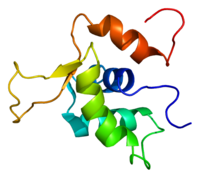
A novel AMPK activator shows therapeutic potential in hepatocellular carcinoma by suppressing HIF1α‐mediated aerobic glycolysis
Sign Up to like & getrecommendations! Published in 2022 at "Molecular Oncology"
DOI: 10.1002/1878-0261.13211
Abstract: Hepatocellular carcinoma (HCC) is characterized by rapid growth, early vascular invasion, and high metastasis. Currently available US Food and Drug Administration (FDA)‐approved drugs show low therapeutic efficacy, limiting HCC treatment to chemotherapy. We designed and… read more here.
Keywords: hif1; hcc; aerobic glycolysis; sct 1015 ... See more keywords

MARK2 potentiate aerobic glycolysis-mediated cell growth in breast cancer through regulating mTOR/HIF-1α and p53 pathways.
Sign Up to like & getrecommendations! Published in 2022 at "Journal of cellular biochemistry"
DOI: 10.1002/jcb.30219
Abstract: The microtubule-affinity regulating kinases (MARKs) family plays a crucial role in regulating breast cancer development and progression. However, its precise function and the relevant molecular mechanism in breast cancer have not yet been elucidated. In… read more here.
Keywords: cancer; breast cancer; aerobic glycolysis; cell ... See more keywords

CEBPB regulates the bile acid receptor FXR to accelerate colon cancer progression by modulating aerobic glycolysis
Sign Up to like & getrecommendations! Published in 2022 at "Journal of Clinical Laboratory Analysis"
DOI: 10.1002/jcla.24703
Abstract: Aerobic glycolysis is a main characteristic of tumors, and inhibited glycolysis impedes the tumor development. Farnesoid X Receptor (FXR) mainly regulates bile acid metabolism. In this research, we mainly investigated whether FXR was involved in… read more here.
Keywords: aerobic glycolysis; receptor fxr; glycolysis; colon cancer ... See more keywords

TPI1‐reduced extracellular vesicles mediated by Rab20 downregulation promotes aerobic glycolysis to drive hepatocarcinogenesis
Sign Up to like & getrecommendations! Published in 2021 at "Journal of Extracellular Vesicles"
DOI: 10.1002/jev2.12135
Abstract: Abstract Rab GTPases are major mediators that ensure the proper spatiotemporal regulation of intracellular trafficking. Functional impairment and altered expression of Rab proteins have been revealed in various human cancers. There is an emerging evidence… read more here.
Keywords: extracellular vesicles; rab; hcc; aerobic glycolysis ... See more keywords

Aerobic Glycolysis Hypothesis Through WNT/Beta-Catenin Pathway in Exudative Age-Related Macular Degeneration
Sign Up to like & getrecommendations! Published in 2017 at "Journal of Molecular Neuroscience"
DOI: 10.1007/s12031-017-0947-4
Abstract: Exudative age-related macular degeneration (AMD) is characterized by molecular mechanisms responsible for the initiation of choroidal neovascularization (CNV). Inflammatory processes are associated with upregulation of the canonical WNT/beta-catenin pathway in exudative AMD. We focus this… read more here.
Keywords: beta catenin; wnt beta; catenin pathway; aerobic glycolysis ... See more keywords

miR-142-3p inhibits aerobic glycolysis and cell proliferation in hepatocellular carcinoma via targeting LDHA.
Sign Up to like & getrecommendations! Published in 2018 at "Biochemical and biophysical research communications"
DOI: 10.1016/j.bbrc.2018.01.112
Abstract: Cancer cells are addictively dependent on glycolysis even in an oxygen-rich condition. However, the mechanism underlying micro (mi)RNA regulation of aerobic glycolysis in cancer cells has not been fully understood. Here, we demonstrated that the… read more here.
Keywords: hepatocellular carcinoma; glycolysis; aerobic glycolysis; mir 142 ... See more keywords

Dihydroartemisinin and Artesunate Inhibit Aerobic Glycolysis via Suppressing c-Myc Signaling in non-small Cell Lung Cancer.
Sign Up to like & getrecommendations! Published in 2022 at "Biochemical pharmacology"
DOI: 10.1016/j.bcp.2022.114941
Abstract: Non-small cell lung cancer (NSCLC) cells exhibit aberrant metabolism characterized by high glycolysis even in the presence of abundant oxygen. Inhibition of aerobic glycolysis remains challenging when identifying potential cancer-specific inhibitors while maintaining or even… read more here.
Keywords: cancer; glycolysis; cell; lung cancer ... See more keywords

A feedback circuit comprising EHD1 and 14-3-3ζ sustains β-catenin/c-Myc-mediated aerobic glycolysis and proliferation in non-small cell lung cancer.
Sign Up to like & getrecommendations! Published in 2021 at "Cancer letters"
DOI: 10.1016/j.canlet.2021.06.023
Abstract: Mammalian Eps15 homology domain 1 (EHD1) participates in the development of non-small cell lung cancer (NSCLC). However, its role in mediating aerobic glycolysis remains unclear. Herein, microarray analysis revealed that EHD1 expression was significantly correlated… read more here.
Keywords: catenin myc; glycolysis; aerobic glycolysis; circuit ... See more keywords

Malic Enzyme Couples Mitochondria with Aerobic Glycolysis in Osteoblasts
Sign Up to like & getrecommendations! Published in 2020 at "Cell reports"
DOI: 10.1016/j.celrep.2020.108108
Abstract: SUMMARY The metabolic program of osteoblasts, the chief bone-making cells, remains incompletely understood. Here in murine calvarial cells, we establish that osteoblast differentiation under aerobic conditions is coupled with a marked increase in glucose consumption… read more here.
Keywords: couples mitochondria; aerobic glycolysis; malic enzyme; glycolysis osteoblasts ... See more keywords

Aerobic glycolysis is necessary for smooth muscle to myofibroblast transition in response to PDGF
Sign Up to like & getrecommendations! Published in 2018 at "Free Radical Biology and Medicine"
DOI: 10.1016/j.freeradbiomed.2018.10.059
Abstract: Atherosclerosis is the most prevalent cause of death across the world. Numerous clinical studies have concluded that decreased plaque stability, not greater lesion size, is a better determinant of rupture and adverse thrombotic events with… read more here.
Keywords: transition; aerobic glycolysis; smcs undergo; smooth muscle ... See more keywords

Bound polyphenol from foxtail millet bran exhibits an antiproliferative activity in HT-29 cells by reprogramming miR-149-mediated aerobic glycolysis
Sign Up to like & getrecommendations! Published in 2019 at "Journal of Functional Foods"
DOI: 10.1016/j.jff.2019.03.021
Abstract: Abstract Colorectal cancer (CRC) is an intractable intestinal tumor. Cancer cells prefer to aerobic glycolysis to meet the requirements of rapid proliferation. Hence, discovery of a bioactive molecule cold inhibit aerobic glycolysis, which is regarded… read more here.
Keywords: bpis; activity; foxtail millet; millet bran ... See more keywords